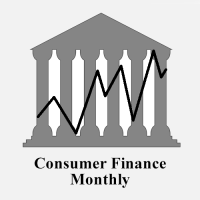
The American economy is the largest in the world, and the American consumer's spending habits drive the American economy. The American consumer increasingly relies on credit cards to make purchases, over $2 trillion per year, so credit card usage has become central to the world economy. Because of its sheer size, the American economy plays a powerful role in determining economic growth around the world. Ironically, despite the importance of the American consumer's spending habits and financial well-being, there was no on-going study of how the American consumer managed his or her money and what the wealth position of the American consumer looked like at the time this project was undertaken. The only detailed study of the American consumer took place every three years. By the time the data was published, it was 2 years old.
The Consumer Finance Monthly (2005-2013) was a study used to track American's financial management - especially how they handle credit, credit cards, their assets and liabilities. This study sampled consumers monthly to uncover important trends in the financial management of the American consumer to detect shifts in spending behavior, financial health and the accumulation of both assets and liabilities.
This was a research project, not a market research survey. The project was based at The Ohio State University and was guided by researchers at Ohio State, the Wharton School of Business, the Federal Reserve Board, and researchers at some of the largest banks in America. These data were used to study consumer behavior, forecast economic activity and track the financial health of consumers. Another major purpose of the project was to study how consumers were preparing for retirement. It's essential to have good data on the assets and liabilities of American households if we are to understand how people are preparing for retirement and managing their assets.
Study Goals
The goals of this study were to determine how people choose and use credit cards, how they manage their loans and liabilities, and to measure their asset holdings to construct a balance sheet for the American consumer. As a part of this effort, we collected household income data to measure how debt payments compared to income and determine how difficult it was for consumers to manage their debts.
Research Team
The original, principal investigators were:
- Dr. Randall Olsen, an Ohio State Professor Emeritus of Economics and CHRR staff member.
- Dr. Lucia Dunn, an Ohio State Professor of Economics. She has studied credit card usage and the role of debt in consumer finances for several years.
- Dr. Jinkook Lee, a former professor of Consumer and Textile Sciences at Ohio State who worked on issues relating to consumer finance.
CHRR services used for Consumer Finance Monthly:
- Sample Design and Management
- Survey and Questionnaire Design
- Survey Management
- Data Collection
- Data Analytics
- Data Security
- Data Administration
- Voice over Internet Protocol (VoIP) Telephony
- IRB Coordination
Service descriptions can be found on CHRR's services page.
Accessing public CFM data
Data collection occurred from 2005-2013 by CHRR at The Ohio State University and can be accessed through CHRR's CKAN online tool:
- Go to the CFM project in CKAN.
- Browse the datasets you'd like to use.
- Click Preview or Download for a specific dataset or file.
Newsletters and other documents about the CFM are available for download through the tool.
Summary of Data
- Credit Card Use
- Credit card use: new charges, outstanding balances, APR, payoff, total minimum payment, total credit limit, rewards and perks, missed payments
- Balance Switching
- Switches in the last 6 months: APR and other terms of introductory offers, switching balances and fees, terms of old credit card
- Details on what would trigger balance switching: the offers rejected and the offers desired
- Consumer Loans
- Total household liabilities by type: mortgages, home equity loans and lines of credit, auto loans, student loans, payday loans
- Loans: outstanding balances, APR, monthly payment and credit limit
- Payoff plans including early payoff
- Default and bankruptcy history
- Consumer Expectations
- Expectations for household financial condition
- Expectations for the market: inflation, interest rates and unemployment
- Consumer Attitudes
- Psychological debt stress
- Attitudes towards social security
- Income and assets
- Total household pre-tax income by detailed source: employment, business income, interest and dividends, pensions, transfers, and other income
- Household assets by type: residences, property, business, liquid assets, stocks and mutual funds, bonds, and other financial and non-financial assets
- Net worth
- Demographics
- Age, gender, education, marital status, ethnicity, household size, employment status
- Geographic region
